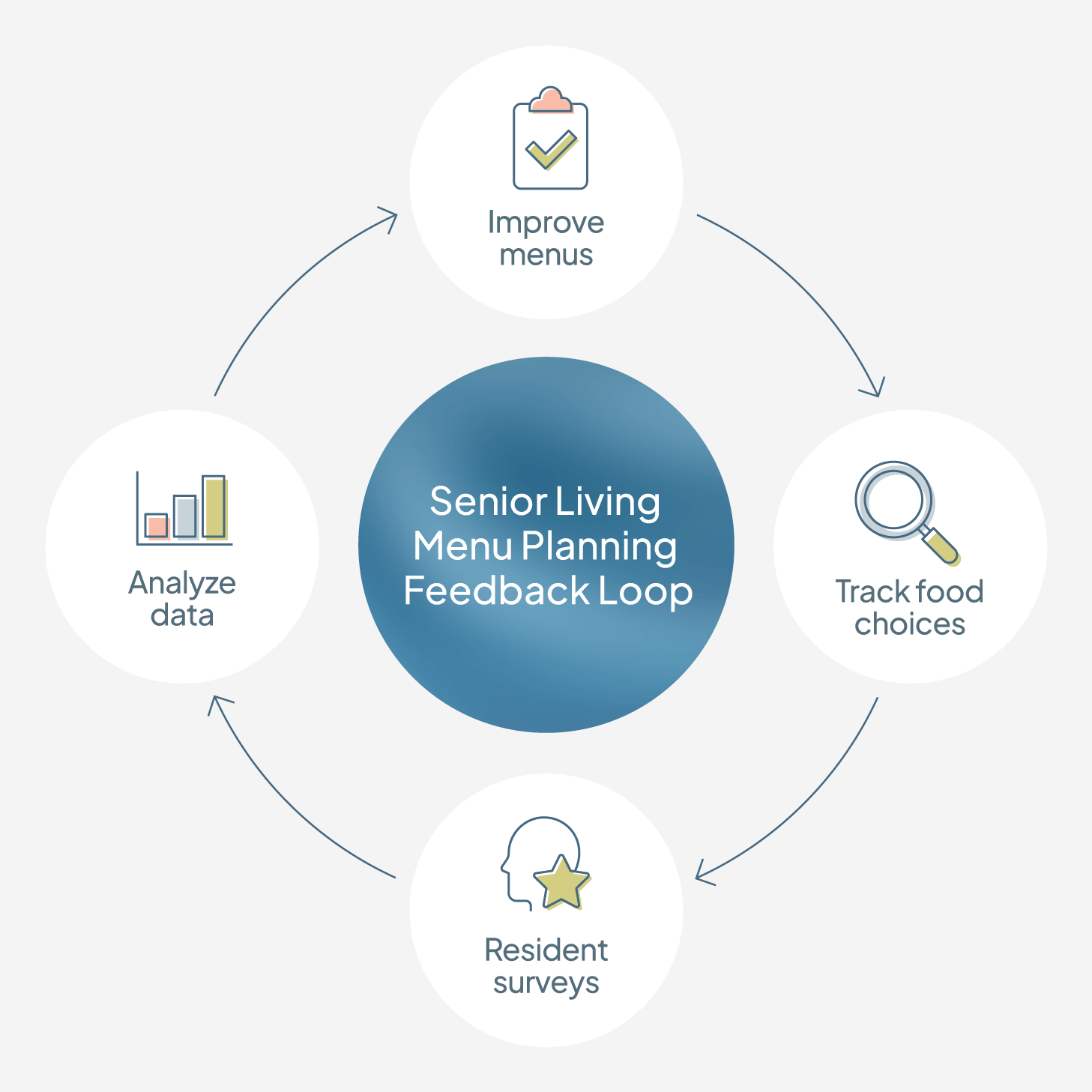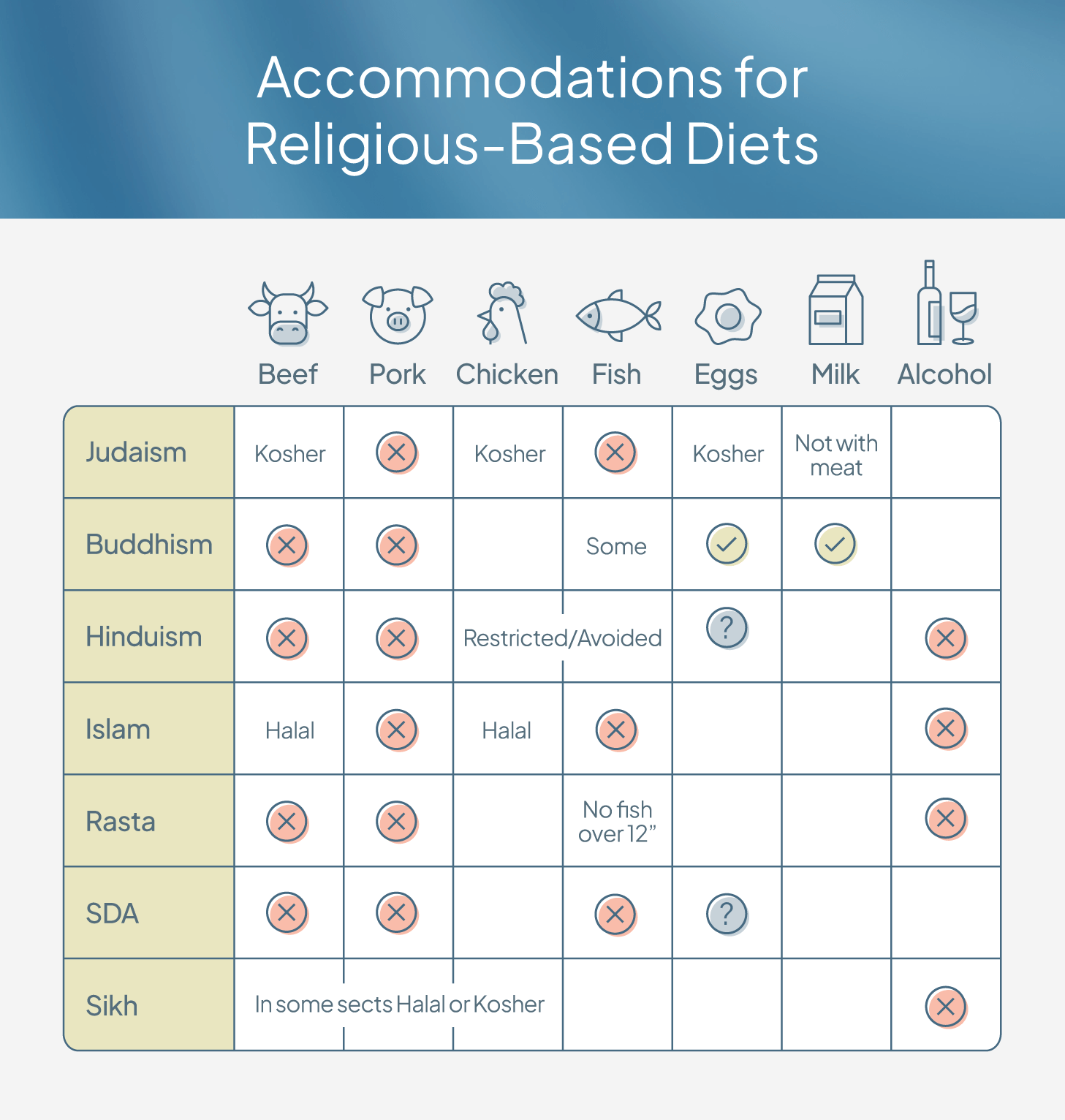Effective Menu Planning for Senior Living
Simplify menu planning in senior living with smart strategies and software that boost efficiency, consistency, and resident satisfaction.

Simplify menu planning in senior living with smart strategies and software that boost efficiency, consistency, and resident satisfaction.
Published on: July 1, 2025
Last updated: July 7, 2025

Thoughtful menu planning in senior living goes far beyond choosing daily meals — it’s a foundational pillar of resident care. A well-structured menu impacts everything from satisfaction and health outcomes to operational efficiency and compliance.
With the right technology and strategic approach, communities can streamline the planning process while supporting diverse dietary needs and consistent food quality. When these pillars come together, they drive stronger operations, healthier residents, and a dining program that truly enhances quality of life.
Strategic menu planning plays a critical role in supporting both resident well-being and operational success. A well-planned meal doesn’t just feed; it supports health, reflects resident choices, and embodies a commitment to thoughtful care.
Done well, menu planning helps communities go beyond regulatory minimums — delivering fresh ingredients, supporting specialized diets, and creating a consistent, satisfying dining experience. At the same time, it creates efficiencies behind the scenes that benefit staff and streamline operations.
Carefully designed menus are essential to supporting residents’ physical health. By tailoring meals to meet senior-specific dietary needs, including restrictions related to chronic conditions like diabetes, hypertension, or heart disease, communities can help prevent malnutrition, strengthen immune function, and promote energy and mobility. Prioritizing balanced nutrition through thoughtful planning also plays a key role in maintaining cognitive health and overall quality of life.
A positive dining experience depends not just on nutrition but on how well meals reflect residents’ tastes, traditions, and preferences. Menus that offer variety, highlight seasonal ingredients, and incorporate culturally meaningful dishes demonstrate a commitment to personalization and quality.
Including familiar favorites and providing choices helps reduce meal fatigue, increase enjoyment, and encourage social interaction. When dining feels personalized and enjoyable, it contributes to a stronger sense of comfort and community.
The right solutions can make a major impact on kitchen operations and the bottom line. Menu planning software, like Grove Menus by Aline, helps communities better forecast demand, streamline purchasing, and manage inventory with greater accuracy. This reduces food waste, eases staff workload, and creates more predictable spending. By aligning food orders with actual consumption, you can avoid overproduction and prevent revenue leakage tied to unused meals.
Senior living communities must navigate a complex web of regulations, especially in dietary services. Kitchen teams are responsible for meeting strict nutritional guidelines, accommodating individual dietary needs, and maintaining food safety standards — all while clearly documenting their efforts.
Menu planning software can ease that burden. With software, staff can easily build dietitian-approved menus aligned with state-specific compliance requirements, track food waste and meal service data, and forecast ingredients for better planning. Storing resident-specific information, such as allergies and dietary restrictions, helps reduce risk and ensures every meal aligns with individual needs safely and consistently.

Effective menu planning depends on a handful of core elements that work together to support both resident satisfaction and operational success.
Here are five key areas that play a central role in successful menu planning.
Implementing menu planning platforms into your senior living operations management system can alleviate many administrative burdens associated with meal preparation, allowing staff to focus more on the residents’ dining experience. These platforms offer an interconnected hub for managing all aspects of the dining program, leading to greater efficiency and accuracy.
Food service platforms often include these features.
Balanced meals are crucial for maintaining resident health, energy levels, and overall quality of life. Thoughtfully constructed menus should do more than provide meals. They should also help prevent malnutrition, support chronic condition management, and address the distinct nutritional needs of older adults.
Registered dietitians are essential in this process. Their expertise ensures that menus include nutritious meals for seniors that align with the specific dietary requirements and therapeutic needs of the resident population. They can develop individualized meal plans, advise on appropriate food textures, and collaborate with the culinary team to create delicious and health-conscious options.
Additionally, consulting with registered dietitians, either on staff or as part of your senior living community operations platform, allows for a person-centered approach to menu planning. All dietary restrictions, allergies, and preferences are considered and accommodated.
Common considerations to plan for include:

This level of consideration safeguards residents’ health while also fostering a sense of respect and inclusivity within the community.
Nutritious meals are essential, but residents should also enjoy what’s on their plates. Offering variety helps prevent meal fatigue while giving residents meaningful choices for a more satisfying dining experience. Small adjustments, like rotating menus or changing preparation styles, can make familiar dishes feel fresh and appealing.
Incorporating regional ingredients and seasonal flavors adds interest and aligns with growing preferences for sustainability. Sourcing local foods, such as wild Maine blueberries or Georgia peaches, enhances both taste and nutrition while reflecting residents’ tastes and traditions.
Familiar favorites also play an important role. Including comfort foods tied to memories or seasonal dishes can can bring back fond memories and create a sense of home. Think fresh fruit parfaits in summer or hearty stews in winter.
And don’t underestimate the importance of visual appeal. Thoughtful plating, appealing textures, and inviting aromas all contribute to the dining experience. When food looks and smells as good as it tastes, it encourages better appetites and overall satisfaction.
Menus should be designed with both the resident experience and kitchen execution in mind. Effective planning accounts for your team’s capacity, available equipment, and time constraints to ensure meals are not only appealing but also feasible to prepare consistently.
Featuring simple, repeatable dishes helps streamline workflows, reduce stress on culinary staff, and support timely service. At the same time, thoughtful menu cycles can maintain variety and quality without adding unnecessary complexity. For example, designing meals that share core ingredients across multiple dishes simplifies prep and inventory management.
Solutions like POS integrations can further enhance efficiency by linking menu selections to production, ordering, and resident modifications. With more accurate data and streamlined processes, your kitchen can operate more smoothly, leading to a more consistent dining experience for residents and a more manageable workload for staff.
Serving good food is essential. But in senior living, the overall dining experience plays an equally important role. Mealtimes are about more than nutrition; they’re opportunities for connection, comfort, and community.
Sharing meals encourages conversation and social engagement, which can significantly impact residents’ emotional well-being. Your staff helps shape this experience by creating a warm, welcoming dining environment, a factor that can be just as influential on resident satisfaction as the quality of the meal itself.
When the atmosphere is positive and inclusive, residents are more likely to look forward to mealtimes, enjoy their food, and feel a stronger sense of belonging. That shared experience contributes meaningfully to overall well-being and quality of life.
Balancing resident satisfaction with operational efficiency starts with thoughtful, well-executed menu planning. Grove Menus by Aline helps your team create personalized, nutritious menus while streamlining kitchen operations, improving consistency, and reducing food waste.
Want to see how it could work in your community? Let’s start with a quick conversation about your current dining approach and where you’d like to improve. We’ll share insights, strategies, and how Grove Menus can support your goals — no pressure, just perspective.


Amanda McGrory-Dixon
Amanda McGrory-Dixon is the content marketing manager at Aline, where she shares expert insights on how senior living communities can streamline operations, enhance resident satisfaction, and drive sustainable growth. With a deep understanding of industry trends and technology, she helps operators navigate challenges and implement data-driven strategies to improve efficiency, profitability, and care outcomes.
Blogs, stories and studies from the forefront of senior living operations

Learn how to navigate the complexities of health care payors in senior living for successful revenue management, streamlined operations, and successful…

Boost leads, personalize outreach, automate tasks, and gain data-driven insights with AI solutions

Better care starts with better insights. Learn how senior living teams are using data and technology to create more meaningful resident experiences.

Learn how to improve employee retention in senior living communities and address one of the industry’s biggest staffing challenges.

Disconnected systems hold teams back. Modern senior living financial reporting improves margins, forecasting accuracy, and operational speed.

Explore emerging challenges, growth opportunities, and what’s ahead for senior living operators.
We’re using cookies on this site to improve your experience. Cookies help us learn how you interact with our website, and remember you when you come back so we can tailor it to your interests.
You can find out more about cookies and usage on our cookie policy page.
Some of these cookies are essential, while others help us to improve your experience by providing insights into how the site is being used.
For more detailed information on the cookies we use, please check our privacy policy
Your experience is important to us. We’re redirecting you to our new Aline website, where you’ll discover how our complete suite of senior living solutions can help you grow occupancy and revenue, optimize operations, and enhance resident care.
For more information, you’re welcome to read our statement on our merger. To continue your web experience, simply close this notification.
Your experience is important to us. We’re redirecting you to our new Aline website, where you’ll discover how our complete suite of senior living solutions can help you grow occupancy and revenue, optimize operations, and enhance resident care.
For more information, you’re welcome to read our statement on our merger. To continue your web experience, simply close this notification.
Your experience is important to us. We’re redirecting you to our new Aline website, where you’ll discover how our complete suite of senior living solutions can help you grow occupancy and revenue, optimize operations, and enhance resident care.
For more information, you’re welcome to read our statement on our merger. To continue your web experience, simply close this notification.
Your experience is important to us. We’re redirecting you to our new Aline website, where you’ll discover how our complete suite of senior living solutions can help you grow occupancy and revenue, optimize operations, and enhance resident care.
For more information, you’re welcome to read our statement on our merger. To continue your web experience, simply close this notification.
2024 Aline Benchmark Report: Your Blueprint for Growth
Discover data-driven insights to maximize occupancy, boost revenue, and optimize performance. Download your free report today.